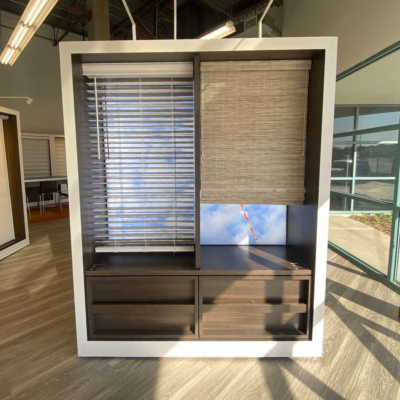Regarding window treatments, two popular options are shades and shutters. While the two may seem similar at first glance, they have distinct differences. Understanding these differences can help you choose the right window treatment for your home. In this blog post, we’ll explore the differences between shades and shutters so you can make an informed decision for your home.
 Style:
Style:
One of the most noticeable differences between shades and shutters is their style. Shades are made from soft materials such as fabric, woven wood, or bamboo and are available in various types, including Roman, roller, and cellular shades. On the other hand, shutters are made from hard materials such as wood, vinyl, or composite materials. Another difference in the style is that shades can raise up to the top of your window or disappear into a cassette, leaving the view to the outside unobstructed. Shutters tilt open or closed, but are always in the window unless the doors are opened into the room. They are like a beautiful additional piece of furniture.
Light Control:
Another significant difference between shades and shutters is their ability to control light. Shades can block out sunlight entirely or allow some sunlight to filter through. However, with a couple of exceptions, shades only go up or down. Shutters are not as effective at darkening a room, but the shutter louvers can be adjusted to allow a specific amount of sun to enter a room, and are therefore highly effective at controlling light.
Energy Efficiency:
The insulation capability of your window treatment is essential, especially if you live in extreme climates or have older windows. Shades are typically better at insulating a room than shutters because they are made from softer materials that can trap air between the window and its surface. Some shades are better at insulating a room than shutters. For example, honeycomb shades can prevent up to 80% of the heat entering your home in the summer and 40% of the heat from escaping your home in the winter by trapping air between the cells. Shutters also provide a barrier between the window and your living space, therefore cutting down on energy costs.
Cleaning and maintenance:
When choosing a window treatment, consider how easy it is to clean and maintain. Both shades and shutters can be dusted to maintain their beautiful look. Shutters can also be wiped with a damp cloth for a deeper clean. Many shades can be touch cleaned with a damp cloth and can also be deep cleaned with an ultrasonic process.
Cost:
Finally, there is the cost factor to consider. In general, shades are less expensive than shutters. Shutters manufacturing is more complex and the cost to produce is more intensive. Both products hold their value and style years after their purchase. Made from higher-priced material.
Choosing between shades and shutters can be challenging, but understanding their differences can make selecting the right window treatment for your home easier. Whether you prefer the softness and warmth of shades or the classic look and durability of shutters, both options offer distinct benefits for your home. Consider your needs, budget, style, and maintenance requirements when choosing. No matter what you decide on, you will surely enjoy your new window coverings, giving your home the warm and inviting look you’ve always wanted.
Let us help you find the perfect window treatments for your home.
Contact Victor Shades to schedule a consultation or stop by our showroom today!
